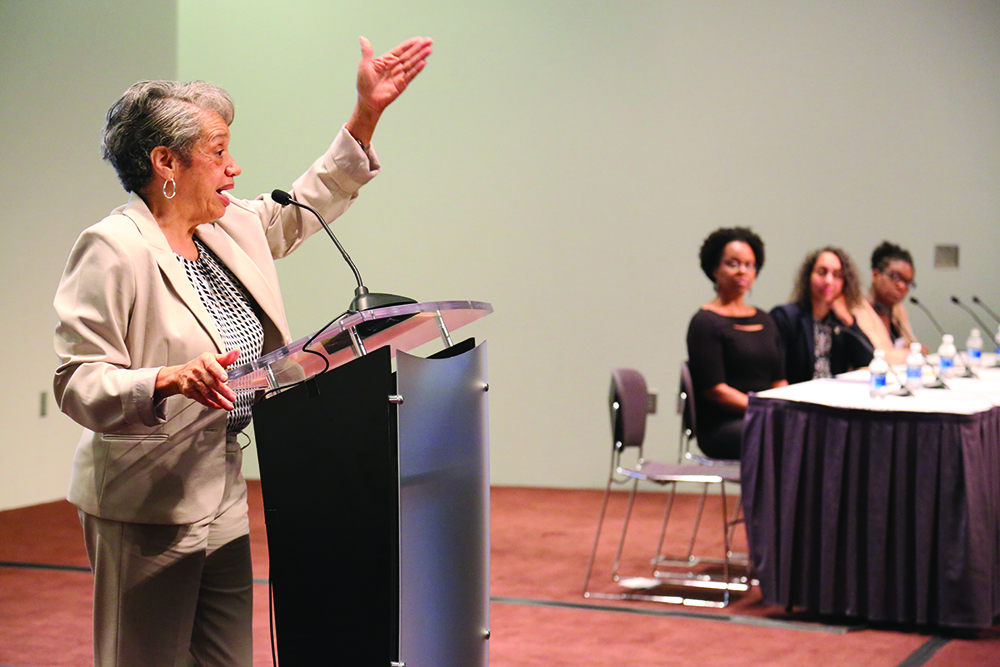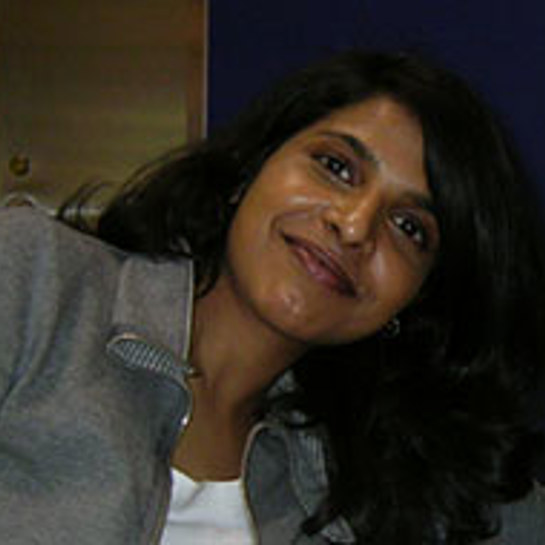Unhidden Figures
It’s not easy to be a black woman in a field dominated by white men. But certain factors—impactful mentors, inspiring role models, and supportive academic environments—alleviate some of the challenges. That was the overriding theme in the stories of four African American women who spoke to a packed auditorium at the “Hidden Figures” panel, which took place at the 2017 SIAM Annual Meeting, held in Pittsburgh, Pa., this July.
“For many of us who are underrepresented, the question is not what encouraged you to study mathematics,” Shelby Wilson, assistant professor at Morehouse College, said. “It’s who encouraged you to study mathematics.”
Plenty of whos inspired three of the panelists—current female mathematicians navigating a male-dominated field—including fellow panelist and hidden figure Christine Darden, a former human computer-turned-aerospace engineer at NASA’s Langley Research Center. Darden’s early findings in the 1960s and 70s resulted in a revolution of aerodynamics design to produce low-boom sonic effects. She was featured in Hidden Figures: The American Dream and the Untold Story of the Black Women Mathematicians Who Helped Win the Space Race, a 2016 book by Margot Lee Shetterly that inspired the film of the same name.
“I’m fortunate enough to have many of my whos in the room right now, many of them across the country,” Wilson said. “And I’m eternally grateful that my grandmother and other hidden figures like Dr. Darden not so much directly affected me, but put my whos into place.”
For Erica Graham, assistant professor at Bryn Mawr College, mentors didn’t always share the same background or experiences, but offered support and encouragement nonetheless. “Although the collection of teachers I’ve had over the years was less diverse, I was never made to question my right to be where I was, so I never did,” Graham said. “The first best decision I made was to choose a college where I had professors who saw my potential and did what they could to draw it out of me. And the most important aspect of completing my graduate education was the support network I developed through various mentors and fellow graduate students, characterized more by collaboration than competition with faculty who clearly wanted us to succeed.”
This is not to say that Graham didn’t face the challenges that come with being an African American woman in a field dominated by people from other racial and ethnic backgrounds. However, she tried to ignore the differences. “In an environment where stereotype threat is very real and imposter syndrome runs rampant, it was essential for me to shed as much unnecessary weight as I possibly could and pretend as though I was just any other graduate student,” she said. “It wasn’t always easy.”
Talitha Washington, associate professor of mathematics at Howard University, attributes much of her success to three mentors who continue to inspire her. “As they always say, behind every successful woman there are a few good men,” she began. Washington spoke about her college mentor and primary inspiration behind her decision to pursue a Ph.D. in mathematics. “I had zero aspirations of going to graduate school,” she said. “I wanted to work in business because that is what I knew. Then along came Dr. Jeffrey Ehme, who took me on as a student researcher in my senior year and forced—yes, he forced me—to apply to graduate school. Had he not made me apply, I wouldn’t be here today.”

Life in graduate school at the University of Connecticut, however, was difficult for Washington. “People always asked me what country I was from,” she recalled. “I was totally confused. I told them, ‘I’m from Indiana, is that a country?’” But then she found her second supportive mentor, Joe McKenna. “I remember sitting in his office devastated by the environment, the workload, and the graduate life,” Washington continued. “He told me, ‘You outwork anyone here, you are good.’ Those words encouraged me to work even harder and see it through.”
In 2001, Washington became the first African American to graduate from the University of Connecticut with a Ph.D. in mathematics. Her third noteworthy mentor, Ronald Mickens of Clark Atlanta University, has helped guide much of her professional career. “He gave me a book on difference equations when I was an undergrad, but it accumulated a little bit of dust,” Washington said. “Little did I know that I would dust it off a decade later, and we would actually begin doing research together.”
Wilson also spoke highly of those who inspired her. “I’ve never lacked role models and mentors in mathematics,” she said. “I’ve had mentors who are mathematical biologists like me, women like me, black like me, socioeconomically privileged like me, and many more who are not like me in all the ways that you can think of.”
While influential mentors come in many stripes, sometimes it helps when role models look like you and have undergone and relate to similar life experiences. For this reason, Graham talked fondly of the Enhancing Diversity in Graduate Education (EDGE) program, intended to increase the number of women and minorities who complete graduate programs in the mathematical sciences. “EDGE was the first time in my life I met black women who had already done what I was getting ready to spend the next several years of my life doing,” she said. “And for me, there is such a normality to their presence that I sometimes forget about the actual composition of the mathematical community. In the years since that first summer at EDGE, I’ve been lucky enough to have a network of friends, colleagues, mentors, and research collaborators, without whom I’d be less likely to be where I am today.” EDGE’s success demonstrates how being in an environment devoid of “otherness” perhaps helped these young women excel.
Washington spoke of the benefits of attending a black women’s college where she did not have to singularly represent an entire race. “I went to Spelman College in Atlanta, Ga., which is a black women’s college, and I was immediately blessed with not being the only black female in the class,” she recalled. “I did not have to explain my race or how I looked. I could simply learn and absorb copious amounts of knowledge that was centered around my perspective as a black woman in a multicultural world.”
Wilson noted that women’s colleges inspire the same kind of unfettered productivity. “If you put women in an environment where their womanhood is not questioned—the term ‘woman’ is nondescript, where a woman is not an active description of you—you have the opportunity to flourish in mathematics,” she said. “It allows you to be more confident and comfortable. I think these [women’s] programs do away with some of the stigma and are helping women.”
What made Darden unique among the panelists wasn’t just that she is profiled in a best-selling book, but also that she came to mathematics at a time when there were no such support groups for women and hardly any female black role models in the field.
None of that stopped her, however. When her father insisted she become a teacher to ensure employment after college, Darden earned her teacher’s certificate while taking several math classes so she could pursue her dream. “I still had this idea that I wanted to do something that was not teaching,” she confessed. “I took my 30 hours of education in student teaching, but I took about 16-18 hours of math that I didn’t have to take as electives. I went on and taught school for a couple of years, and while I was teaching I started going to Virginia State University, taking in-service classes in higher mathematics.”
When Darden learned that women were getting passed over for promotions during her time at NASA, she stood up to her supervisors. “I worked as a human computer for five years until I found out that a lot of the men we were supporting—the engineers—were math majors too,” she said. She asked her supervisor about transferring to an engineering area, but to no avail. A few months later, Darden decided to talk to somebody higher up. “I went to a director who was about three to four levels higher and said, ‘I just want to know why men and women coming here with the same background are assigned to such different areas — you are putting the women in the computer pools where they don’t write papers and don’t get promoted. Men with the same degree are going into engineering, they are working on their own projects, they are writing papers, and they are getting promoted.’ He said nobody ever asked that question before.”
Within two weeks of that conversation, Darden was promoted and transferred to an engineering section. “That’s what I really felt was the beginning of my career at NASA,” she said.
Washington referenced a pioneer in the African American community who still motivates her. “At Howard University, our departmental meetings are held in a room with a picture of Dr. Elbert Frank Cox, the first black person in the world to receive a Ph.D. in mathematics,” she said. “I didn’t learn about Cox until I was fully grown, post-Ph.D. Even though we grew up in the same neighborhood in Evansville, Ind., for me, he was hidden. He spent most of his career at Howard, as [have] I. I often stare at his photo and I’m encouraged just by looking at it, I’m encouraged to continue the pursuit of mathematics and justice.”
Young mathematicians from underrepresented communities today owe much to people like Cox and Darden—and Dorothy Vaughan, Mary Jackson, and Katherine Johnson, all of whom were featured in Hidden Figures—who paved the way for future generations.
“As a mathematician, mother, and activist, I hope that we all remain unhidden so that our children can see that they too can become mathematicians,” Washington said.
About the Author
Karthika Swamy Cohen
Former Managing Editor, SIAM News
Karthika Swamy Cohen is the former managing editor of SIAM News.

Stay Up-to-Date with Email Alerts
Sign up for our monthly newsletter and emails about other topics of your choosing.



